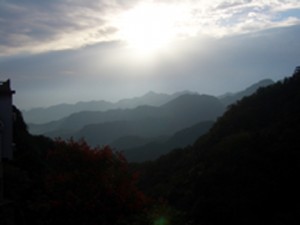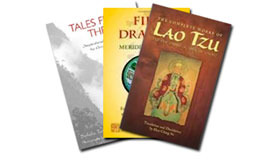My but time doth fly by these days!
My good news is that I just sold my new book on using the Tao Te Ching as a manual for self-cultivation to Sounds True, a great publisher! It will be out in the Spring of 2016. (Books, like people, take a long gestation period.)
Here’s a small taste of what will be included:
Step 52
All beings under heaven have an origin
which is the Mother of all things.
To know the Mother is to know her children.
To know her children
yet to be connected with the Mother
is to live to the end of one’s life without harm.
Shut your mouth and close the door of your senses
and you will live long with no troubles.
If you keep interacting with the world,
seeking to control the world,
and leaving the sense gates open
there will be no redemption.
Perceiving the small is called illumination.
Preserving the soft and yielding is called strength.
Use the light to return to inner light.
You will not invite disaster
and will enter the eternal.
THE COMMENTARY
Here again we see the image of Dao as the Mother of all things. To know or understand the source, the Mother, we need to know her children, us. To really know and understand ourselves is to be connected to this cosmic source. Not only that but to experience our deep connection to this source is to live to the end of our days without harm. It is when we experience ourselves to be deeply connected to our source that we are able to dance with the winds of change and flow with the challenges and opportunities life has to offer.
Next we are given instruction on deep meditation or stillness practice. Closing our mouth and shutting the door of our senses is to go into deep meditation. In this way we can live a long life with less troubles than the person whose sense doors are constantly open and being overwhelmed by the ways of the world. The person who never spends quiet time going within ends up being a victim of his or her projections, fantasies and perceived threats and wrongs done them by the outside world. By seeking to control the world outside of themselves they become cut off from the real world within and lose that all-important connection to the Mother.
It is often in the small moments of life that we are able take the time to really understand who and what we are. Life is made up not of one grand adventure after another, but by each uninteresting moment. To understand and cherish this is called illumination (lit from within).
We all have personal cycles. Sometimes we’re up, other times we’re down. Of course, we enjoy our high cycles much more than our low ones. But we often learn much more from our low cycles. By honoring them and paying close attention to what they have to teach us we can become wise.
The next line reminds us that what the world perceives as soft and yielding is actually a form of strength. This is not the strength of yang, which is easy to see but the strength of yin. Not as easy to see with our outer eyes perhaps but, in the long run, will last much longer than the fiery, easily burned out yang.
The last lines refer to the practice of “turning the light around.” The practice of turning the light around has much to do with turning the light of attention or consciousness onto the original mind or consciousness. In this in turning the light around or allowing the light to penetrate into the dark recesses of our mind, that we can allow our true, essential self or Dao nature, to emerge. Once we no longer identify solely with our own intellectual and energetic constructs we can more easily differentiate what is real from what is false, what is eternal from what is passing.
The more deeply the practitioner is able to let go of the attachments of the mind, the more assistance, at both a spiritual and energetic level, comes his way. Effort as a product of the mind interferes with the free flow of abundant living. Dropping out of the effortful mind, giving up an effortful way of living, allows that which was blocking the natural flow of abundance to disperse. The Daoists call this the ming shen, the radiant mind or spirit.
THE PRACTICE
The practice of turning the light around is the subject of a famous Daoist work called The Secret of the Golden Flower (Taiyi Jinhua Zongzhi), written by the famous Daoist immortal Lu Dong Bin. This text gives us instructions on how to gather and refine our original spirit. Here the image of gold is used to represent the light of the original spirit with the flower representing the awakening or blossoming of that spirit.
Turning the light around refers to the practice of turning our attention inward so that we can arrive at the original mind, or what the Buddhists call “original face.’ This is also called “the mind within the mind.” How do we do this?
Thomas Cleary, in his masterful translation of this text, says:
In general, what is most essential at the beginning of this study is self-refinement. Self-refinement is a matter of mind and breathing resting on each other. This means that the mind rests on the breathing and the breathing rests on the mind. [1]
What this means is that we use the breath to calm the mind down and we use the mind to follow the breath. As in our other meditation practices we allow our breath to become very slow, very deep and very quiet. We allow our breath to become so natural and unforced that it is as if we are not consciously breathing anymore but are “being breathed.”
And as we allow our breath to move in this way our mind also becomes quieter, less active and slows down. Our mind is all to often running madly around in circles. This is what the Buddhists call the “monkey mind” and the Daoists call “the wild horse.” It is not necessary to kill the horse, we only want to tame it. Some people think that we need to stop thoughts altogether but this is not only a very advanced practice, but is in actuality just about impossible. No matter, the more we can quiet our mind the quieter our spirit (shen) will become.
Sit on a cushion or on the edge of a chair. It is important to keep your body erect, without being stiff. Imagine there is a thread coming from your baihui (top of head) up to the heavens that gently holds your head up. Place the tip of your tongue on the roof of your mouth and breath slowly and deeply into your lower dantian. Either close your eyes completely or leave them open just a little, focusing on the tip of your nose. If you eyes are closed just look straight ahead.
Allow your thoughts to gently slow down until you can keep one thought. There is an old saying about how to enter this tranquil state. “Substitute ten thousand thoughts with one.” This means instead of letting the wild horse run all over your consciousness gently guide him onto one path only and keep him there. He will want to run all over the place but keep guiding him along the one path. One of the ways to do this is to focus on the breath. You can count up to ten or even higher, though it is better not to go above thirty six. (One inhale and one exhale counts as one breath.)
Now turn your sight inward, focusing your attention on your lower dantian. Put all your attention on your inner self and let go of your outer self. The outer world is such a distraction that for most people, even when they are meditating, it has a strong hold on them. Now is the time to let all of that go. Turn your gaze away from the world in into your deep inner self. This practice is to connect you with your original spirit, or as the Zen teachers say, “the face you had before you were born.” This practice is also called “inward gazing.”
Thomas Cleary says:
The conscious spirit is a complex of modifications of awareness, while the original spirit is the essence of awareness. [2]
By practicing in this way we reach the level of what the Daoists call ‘living midnight,’ a state of profound mental stillness and quietude, which allows the original or celestial spirit to come forth. It is a way to get in touch with the source of our awareness rather than just the outer manifestations of it.
With practice you will be able to understand better where your mental constructs are coming from and how to dismantle them when they are no longer needed. You may also experience things like warmth or tingling in your dantian or even things like lights and sometimes even sounds. Of course we are always taught not to get too excited about these things or at least not cling to them. For many people there are no special effects, just a feeling of deep quietude, where the outer mind slows down or even recedes and the inner light of true awareness is able to shine forth, resulting in deep relaxation, trust in your own spiritual processes and a deep awareness of your connection to source, to Dao.
It is also good to have a positive and relaxed attitude towards your meditation. Hua-Ching Ni tells us:
If your attitude toward meditation is too tight and you sit solemnly and stiffly, you will nourish and increase this overly serious and unpleasant aspect of your practice and this will become the sour fruit you bear. If, on the other hand, you sit with genuine joy, the world sings to you; the pores and cells of the breeze dance for you. [3]
End this practice as before, with rubbing your hands together thirty six times and then rubbing up and down your face. It is also a good idea to sit for a few moments to gather yourself before entering back into the outer world of ‘doing’ after spending time with ‘being.’ Don’t just jump back into your day but enter it slowly. You may also be a bit sensitive at first so it is best not to enter into any kind of emotionally disturbing communications right away.
The wise one who preserves peace
in his inner self
encounters no dangers on his way.
He can fight in a battle
and not be harmed by weapons.
He has nowhere for the rhinoceros
to stick his horn.
Tigers can find nowhere
to use their claws.
No weapon can harm him.
Why is this?
Because he has no place
for death to enter.
Daode Jing Chapter 50
Affirmation:
If I am able to find
true peace within myself
I will encounter no challenges
I cannot deal with.
I can encounter these challenges
with no harm to myself.
Because of this
there are no challenges
that can truly harm me.
Why is this?
Because I have no place within me
for defeat to enter.
Commentary: If we are truly able to live our lives full of inner peace we will not attract disruptive energy and experiences. And if we do, we can gracefully dance with them, like performing a kind of emotional taiji (tai chi) and either deflect the energy or deflate it.
It is because we are truly peaceful inside that we have the inner confidence and strength to deal with the challenges of life and, instead of being defeated by them, become wiser and larger, more expansive beings instead.




